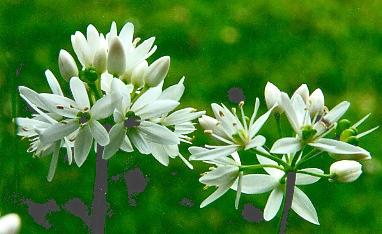|
|||||
|
|||||||
|
    An initiative of :Stichting Food-Info
|
| Food-Info.net> Food Products > Spices Bear's garlic (Allium ursinum)Plant familyAlliaceae (onion family) Botanical synonyms- OriginNative to Western and Central Europe. In the USA, ramp (Allium tricoccum), a wild plant with more onion-like flavour, is used for similar purposes. Used plant partYoung leaves, preferably fresh. They should be harvested before the plants starts flowering. The bulb, being much smaller than that of garlic, is only rarely used. Sensoric qualitySimilar to garlic, but less strong and with a hint of chives. Main constituentsSimilar to garlic, bear's garlic contains a large number of sulphur compounds: divinyl sulfide, dimethyl thiosulfonate, methyl cystein sulfoxide and the latter's degradation products, methyl allyl thiosulfonate and methanethiol.
 Flower of bear's garlic UseBear's garlic, growing wild in fens and river woods of Central Europe, is much used in local cuisines, but since it cannot be cultivated, it has not gained any superregional importance. In spring, the leaves are collected and used raw to flavour spreads based on cottage cheese, soups and sauces. Dried leaves usually exhibit a very faint odour and should, if ever, used in liberal amounts. In Germany, and probably other parts of Central Europe, bear's garlic has increased dramatically in popularity within the last few years. Since bear's garlic has become so popular, many people have tried to collect the plant in the wild. Several cases of poisoning have been reported in the last years, as there are a few toxic plants with roughly similar leaves, particularly lily of the valley (Convallaria majus ) and autumn crocus (meadow saffron, naked ladies, Colchicum autumnale). Both plants do not show even traces of garlic odour, and similarities are in the best case superficial, or even non-existent. Source : www-ang.kfunigraz.ac.at/~katzer/engl/spice_welcome.html |
|
| ||
| Food-Info.net is an initiative of Stichting Food-Info, The Netherlands | ||||||